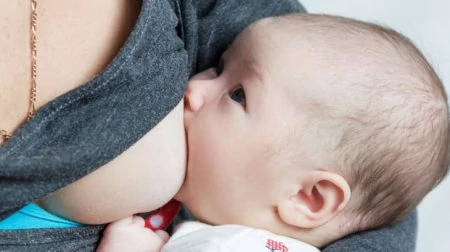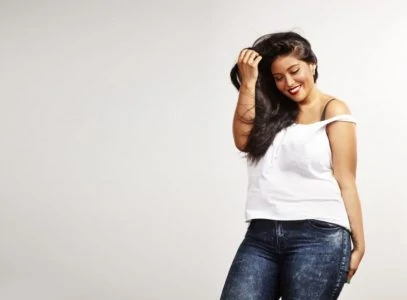We know how pesky it can be to find the right-sized bra for maternity and nursing.
We also know how awkward it can be to go to a store and have someone get all up in your business to get measurements.
In this guide, we’ll discuss the ins and outs of finding the right maternity and nursing bra size for you.
Key Takeaways
- Proper bra fit is important for comfort and to prevent issues like breast pain, stretch marks, and bad posture.
- To find your bra size, measure your band size and cup size, then subtract the band measurement from the cup measurement to determine cup size.
- Check for proper fit in cupped bras and sports bras by ensuring the band, straps, and underwire (if applicable) are snug but not too tight.
- Maternity and nursing bras have added features like removable straps, extra padding, and wider straps for more support during pregnancy and nursing.
Importance of a Proper Bra Fit
Nothing is worse than an improperly fitted bra, maternity or not. When you have clothing that covers one of the most sensitive parts of your body, comfort is vital. This goes for any bra, not just the maternity and nursing varieties.
Wearing a bra that doesn’t fit properly can also lead to several breast issues:
- Breast pain: This is the most obvious issue. Your breasts carry a fair amount of free weight. If you aren’t used to less support, an ill-fitting bra can cause pain in your boobs.
- Stretch marks: This happens when your skin stretches or shrinks quickly (1). In this case, an improperly fitting bra may cause your skin to stretch unnecessarily, which causes these little scars to form.
- Neck, back, and shoulder pain: This is another issue for women with bigger breasts. The weight from your chest makes it hard for your back, neck, and shoulders to support everything.
- Bad posture: This is especially true for women with bigger busts. If you’re not adequately supported, the weight of your breasts can make you hunch forward to hold the weight.
- Rubbing/chafing: If your skin chafes enough, it can lead to skin abrasions. This can be uncomfortable, especially if you already feel huge when pregnant.
Among other things, improperly fitted bras have also led to permanent shoulder grooves from tight straps and an increased desire for breast-reduction surgery. A study showed that ill-fitting bras have caused many women to seek out mammoplasty (2).
How to Determine Your Bra Size
Finding your correct bra size is easy. Follow these simple steps.
- Determine your band size: To do this, take a tape measure and measure around your chest. The tape measure should be placed just below your underarms and bust, where the bra band would sit. This number will be the number in front of your cup size when finding a bra.
- Determine your cup size: This involves taking your tape measure and wrapping it around the fullest part of your breasts. This measurement shouldn’t be so tight you’re squeezing your boobs, but it shouldn’t be so relaxed that the tape measure is hanging loose either.
- Subtract your band measurement from your bust (cup) measurement: This will give you your cup size. If the difference is one inch, you’re an A cup. For every inch above that, you add a cup size, so a four-inch difference is a D cup.
Bra Fit According to Style
Whether you prefer the underwire style or a sports bra, there is a way to know if it’s properly fitted. For the most part, you’ll know if you feel comfortable wearing it. However, even then, it can be hard to tell if the fit is correct.
Cupped Bras
When determining the fit of a cupped bra, run through this list to check if everything is correct:
- Under band: This is where most of your support will come from — it’s the correct size if it fits evenly around your body. The back shouldn’t feel loose or be hiked up and should stay in place when you’re jumping around. You can determine it’s a proper fit if you can comfortably fit two fingers underneath it.
- Shoulder straps: These should be snug but not too tight — you should be able to fit two fingers underneath the strap. The straps shouldn’t be so tight that they dig into your skin. But they should be loose enough to slip off your shoulders. It’s all right if one strap is slightly tighter than the other.
- Cups: Aim for a snug fit. The cups shouldn’t be so small that your boobs spill over or so big that the cup sticks out.
- Center front: This is the space between both cups. This part should sit flat against the chest.
- Underwire: If you have an underwire bra, ensure it isn’t sitting on any breast tissue. To check this, push on the underwire and feel if anything seems squished. This is especially important if you’re breastfeeding or plan to breastfeed.
Sports Bras
The point of sports bras is to minimize the movement of your breasts during physical activity. There are three different styles of sports bras — encapsulation, compression, and a combination of both.
Encapsulation sports bras have individual cups that support each breast separately. These are similar to regular bras, so the fit check will be virtually the same.
With compression sports bras, movement is more restricted as it compresses your breasts down. We don’t recommend using this type of sports bra if you plan on breastfeeding because it can limit your supply due to plugged ducts (3).
Combination sports bras offer the most support and are good if you’re a fairly active person. They’re best for high-impact activities.
To ensure your sports bra is the right fit, consider this checklist:
- Check your band: Do the same check as you would with a regular bra — it should be snug but not too tight. If you can comfortably fit two fingers underneath, the fit is correct. Wider bands will be more supportive than narrow ones.
- Check your straps: Once again, do the two-finger test, but make sure the straps aren’t digging into your shoulders. Wider straps will be more supportive. It’s also worth it to see if the straps are adjustable because they will come in handy if your boobs are growing during or after pregnancy.
- Back closure: Some sports bras will come with a back closure. This can help get a more proper fit than a compression or combination sports bra that doesn’t have one.
- Underwire check: If there is an underwire, do the same check you would do with a regular bra. The underwire should sit flat on your chest and shouldn’t squish anything.
Maternity/Nursing Bras vs. Regular Bras
We’ve discussed bras in general, but what is the difference between maternity/nursing bras and regular ones? They’re more or less the same, but they come with a few extra features to accommodate nursing mothers (4).
Removable Straps
Perhaps the most notable difference between regular and nursing bras is the clasp to remove the straps. These are meant for easy nursing after the baby is born.
Rather than slipping off the entire strap and sitting awkwardly, these clasps allow you to access your breast quickly. The clasp is typically located at the top of the cup, where it meets the strap. You can unclasp the strap and move the cup out of the way for nursing, then refasten it when you’re finished.
Added Support
Anybody who has been pregnant or has nursed a knows the struggle of constantly-growing boobs. This gets uncomfortable, and you don’t want to have to keep buying new bras every time they go through a change. You’ll end up with a bunch of bras in varying sizes that you might not use again.
Maternity and nursing bras are made with extra padding and more support to accommodate this. They also come with wider straps to help hold the girls up a little better. Wide-strapped bras tend to provide more support than thinner straps, distributing weight more effectively.
Maternity and nursing bras usually come with extra hooks in the back too. Because the band is where most of your bra support will be, this is essential for a comfortable and supportive bra.










